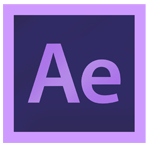
After Effects Tutorial: 3D Mosaic Effect
Create a 3D style mosaic animation in After Effects – perfect for making logos and titles more dynamic!

In this After Effects tutorial, you’ll learn how to break apart text or a logo into a mosaic pattern and then quickly reassemble it for an impressive reveal. All of the AE tools used in this tutorial come default with the app, so there’s no need to purchase any fancy (read: expensive) third party plugins or filters.
Although some AE experience is suggested before taking on this mosaic animation tutorial, it doesn’t require any advanced scripting or expressions. The fundamentals of the tutorial include:
- Applying the Fractal Noise plugin to text or logo
- Using the Card Dance plugin to break the text or logo into a mosaic pattern
- Simulating movement of the mosaic tiles with the AE virtual camera
- Applying Force Motion Blur effect to the animation for a smoother effect
Although the effect seems like a likely fit for text or a logo, it can actually be applied to any video or graphic element in your AE project. Best of all, the affected element sits in it’s own comp, so you can quickly swap it out for something else with the same animation applied. For example, if a client decides they want to update their logo you won’t need to go through all of the steps of reanimating it, simply swap out the logo in the comp.
This AE mosaic effect is quite simple and will add pizazz to a video editing or motion design project.
Tutorial best viewed in full screen:
Full Video Tutorial Transcript
[color-box color=”gray”]
EVAN ABRAMS: In this After Effects tutorial from Premiumbeat.com we’re going to create a 3D mosaic break-apart and come together of a logo, or really anything. It’s going to be using the card dance plug-in and a couple of other things to shore it up, so let’s get into it. So inside of After Effects the first thing we’re going to do is create a new composition, and in this case we’re going to use the HDTV 1080 24 frames per second preset, and we’ll set the duration to 30 seconds even though we won’t use all of it.
Now, the first thing we need to do is create a place holder for the logos or the elements that you’re going to break apart using the mosaic effect. For this case we’ll just make a new text layer and we’ll just type in logo. And we’re going to use sort of a gold-brown color, and we’ll shrink it down so that it fits more or less towards the center and we can use the align panel to put it right in the middle.
Now on the logo we might dress this up with a drop shadow, just to give it a bit more visual interest. So we’ll give it a white drop shadow, set it’s opacity to 100, put up the distance above 15, and then we’ll also go into the character palette here and we’ll add a stroke to it. So this will serve as the logo for the piece, and what we’ll do is we will pre-compose this so, control-shift-C, and make sure you have move all attributes to new composition. We will call this the logo comp, and all of the things that we do are going to happen to this logo comp. If you need to change anything you just go inside and change it. So, comp 1 out here should be renamed final export, because this is where things will be exported from.
Now the next layer we have to make is a control layer, so we’re going to make a new solid, and we’ll make it the comp size and we can set it as white or black, or it doesn’t really matter because we’re going to cover it up using fractal noise. Now fractal noise will generate this nice sort of cloud pattern, and you can change the fractal type and the noise type and all sorts of things. But for our purposes what we’re really interested in increasing the contrast a little bit, perhaps to 150, and you can tweak the brightness if need be. But I think we’ll leave it pretty much as is. We just want to make sure you can see pure black spots and pure white spots, and there is considerable amount of change going on throughout; because this layer is going to control what happens in the next part.
The first thing to do is pre-compose this, so control-shift-C again, or Cmd-shift-C, and call this the control comp. And we would like to move our attributes into the new composition so the fractal noise we created stays on that solid and goes into the composition; and hit OK. And you can drag this below the logo comp, or just poke its eye out, because we don’t need to look at it. Now on the logo comp we are going to use something called the card dance, and the card dance basically will break up this layer into a bunch of small cards and then it will animate them using another layer. So we have to say, gradient layer 1 is now the control comp. That means it will be using that gradient and that fractal noise that we put on there, and then multiplying the values underneath the cards and using that to generate position and rotation changes in those cards.
So, the first thing we want to do is change the rows and columns of these cards. This will divide the layer up into various rows and columns in order to make the cards. So we would like 90 rows and 160 columns; so we’re dividing its height here into 90 pieces and we’re dividing the width into 160. Since this is a 16 x 9 composition that’s divide it up into squares. Now, when we go down here to the Z position and we say, use the source’s intensity, you can see that it starts to fragment apart into a bunch of little squares. And as you increase the multiplier they start to go all over the place. So let’s set the multiplier at 25 and we’ll set a key frame here at the beginning for it to be at 25, and we’ll most ahead 30 frames holding down shift and page down. And then we’ll set the multiplier down to zero. So the layer kind of collects itself together out of all of these pieces.
And we can also put in similar things for the X and Y position as well. So we’ll go back to the beginning here and we’ll set key frame for those. So we’ll set the multiplier here for the X position to be at 25 as well; and we will set the multiplier for the Y position to be at 25 as well. And then we’ll set the source to be intensity one for both. And you can see it spreads them out quite nicely. And you’ll probably need to refine this just to make it a little bit more cohesive so that it isn’t going all over the place.
These don’t have to be as extreme, because we are going to also add movement using a camera. So let’s just call up those key frames by hitting U, and then advancing to where they should all come together and making sure they’re all at zero. And we can see how that all comes together. We’re going to want to easy-ease them all into their end state just so it doesn’t happen so abruptly. And now we’re going to create a new camera to add more motion. And we’re going to use the 24 mil. preset, hit OK, and go into the logo comp here. And we’re going to have to tell it to use the camera that is in the comp. So it has built-in camera controls, but we would like to use the composition camera to move things around.
So what we’re going to do is we’re going to take this camera and we’re going to transform its position. So, we know its final position should be here, so set a key frame. And before we animate it we want to go layer transform R orient and remove its auto orientation towards this point of interest. It causes too much confusion when you start moving the position, but it’s still locked and staring at a fixed point that doesn’t actually move as well.
So now move back to the beginning and we’ll just push the camera forward through this mass of particles until it reaches a point where there are no participles, or there are so few that it doesn’t really matter. And then we’ll also easy-ease that last key frame so that it’s pulling out as it’s coming together; so that looks pretty good. And we’d also like to add a rotation, so put a key frame for the Z rotation, or zed rotation, go back to the beginning and we will just induce perhaps 180 or 90 rotation there so it spins as it comes out, and again, easy-easing that last key frame.
So we have the logo coming out and coming together quite nicely. In order to add a motion blur to this though we have to force it to have motion blur. So, type in force motion blur on the effects, and then drag that out onto the composition. And what this does is it over rides any native motion blurs because this effect actually can’t have normal motion blur applied to it. In fact, it doesn’t believe the layer is moving at all, and if you tried to apply motion blur to it it doesn’t believe there’s any vectors for it to apply.
So that brings the logo together. We’re going to advance a few frames, as long as you want to have it on. And now to remove the logo we’re going to simply key frame the position, the rotation, and those multipliers again, and move ahead only 10 frames. And now we’re going to set all of these up to be 25 so it’s fragmenting apart. And we are going to go in at -180 on the Z rotation, and we’re going to push back in using the camera’s position. So at around 50 it’s all gone; that’s good. So we can see when it gets ready to break itself apart it’ll look kind of like everything’s flying at the camera; in some kind of vortex.
So that’s working out for me. What we’ll do now is we’ll take these inside key frames here of the camera’s movement and we’ll just turn them into auto beziers, which means that these key frames here in the middle are going to be the result of a tween between the two on the edge, just so it has continuous motion and isn’t so boring.
Now, the last thing to do is to just take these layers and style them a little bit. So we’ll make a new solid that will serve as the background;
set it to whatever color of gray you think is important. But we’re going to use a ramp on that, and what I like to do is use a radial ramp, move the inside to be close to the middle, and move the outside to be beyond the corner; set the end color to be something dark, like 5, and set the inside color to be something a little bit lighter, like 25.
Now we can apply a drop shadow to this layer here, and we will set it to be at a distance of 25 and a softness of 25. And we’ll just put the motion blur below that, and you might have to amp up opacity, so you can see it a little better; but there it is. And now what we’ll also be doing is we’ll be adding an alpha bevel, so bevel alpha; again, put that above the drop shadow and set it to a value of 4.
Now what this does is it appears that the shadow is being cast on the background, so instead of it looking like we’re pushing a camera through something it’s more like these are coming from behind the camera or materializing in some way. So that shadow just helps to ground the image. And that’s about it. You can do this for example on this text placeholder, and then if someone comes around with a logo they would prefer you to use you can just go in and place it in the comp.
Now what you can do is also change it, and just to show you what it looks like when you change things I will put in a star here that has rather ridiculous colors, just scale that down and remove the logo we originally made. And so now you can see that it works for just about anything that you put in there. So this has been Evan Abrams for Premium B.com, your source for royalty free sound effects and music. If you want to learn more go to After Effects or other applications; stop by the blog. There are plenty of other tutorials and tips and tricks from industry experts there. And as always, I’m Evan Abrams, thank you so much for watching, and I’ll see you next time.
[/color-box]



